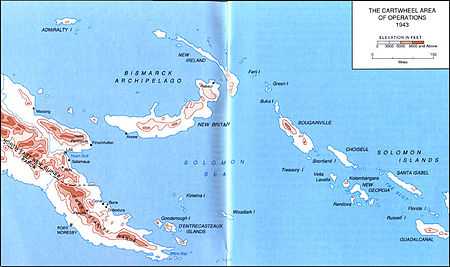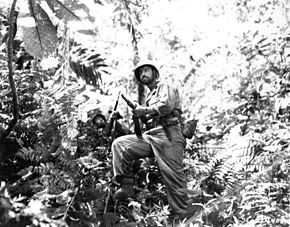New Georgia Campaign
| ||||||||||||||||||||||||||||||
The New Georgia Campaign was a series of battles of the Pacific campaign of World War II. It was part of Operation Cartwheel, the Allied grand strategy in the South Pacific. The campaign took place in the New Georgia group of islands, in the central Solomon Islands from 20 June-25 August 1943, between Allied forces and the Empire of Japan.
Background

The Japanese had captured New Georgia in 1942 and built an airbase at Munda Point which began operations in December 1942 to support the Guadalcanal offensives. As it became clear at the end of 1942 that they could not hold Guadalcanal, the Japanese commanders guessed that the Allies would move toward the Japanese base at Rabaul on New Britain, and that the central Solomon Islands were logical steps on the way.
The Imperial Japanese Army believed that holding the Solomon Islands would be ultimately unsuccessful and that it would be better to wait for an Allied attack on Bougainville which would be much less costly to supply and reinforce. The Imperial Japanese Navy preferred to delay the Allied advance for as long as possible by maintaining a distant line of defence. With no effective central command, the two Japanese services implemented their own plans: the navy assumed responsibility for the defence of the central Solomons and the army for the northern Solomons.
By early 1943, some Allied leaders—notably the supreme commander in the neighboring South West Pacific Area command, General Douglas MacArthur—had wanted to focus on capturing Rabaul, but Japanese strength there and lack of landing craft meant that such an operation was not practical in 1943. Instead, on the initiative of the U.S. Joint Chiefs of Staff, a plan known as Operation Cartwheel was developed, which proposed to envelop and cut off Rabaul without capturing it, by simultaneous offensives in the Territory of New Guinea and northward through the Solomon Islands.
In early 1943, Japanese defenses were prepared against possible Allied landings on New Georgia, Kolombangara and Santa Isabel. By June 1943, there were 10,500 troops on New Georgia and 9,000 on Kolombangara well dug in and waiting for an Allied attack.
Landings

The first Allied landings were on 20 June 1943 by the U.S. 4th Marine Raider Battalion at Segi Point on New Georgia. There was no resistance, and airfield construction began there on 30 June. From 12 July, planes operating from Segi Point Airfield provided close air support for the battle.
On 30 June, the 4th Raiders captured Viru Harbor. The main landing was made on the same date at Rendova Island, south of Munda. Munda point, the Japanese airbase on New Georgia Island, was the main objective of the assault on the island. This base was not taken until 5 August 1943.
The Japanese facilities at Bairoko Harbor—8 mi (13 km) north of Munda—were secured by American forces on 23 August, after weeks of difficult jungle operations. Fighting continued on islands west of New Georgia until October 1943.
| Wikimedia Commons has media related to New Georgia Campaign. |
Notes
References
- Alexander, Joseph H. (2000). Edson's Raiders: The 1st Marine Raider Battalion in World War II. Naval Institute Press. ISBN 1-55750-020-7.
- Altobello, Brian (2000). Into the Shadows Furious. Presidio Press. ISBN 0-89141-717-6.
- Bergerud, Eric M. (1997). Touched with Fire: The Land War in the South Pacific. Penguin. ISBN 0-14-024696-7.
- Feldt, Eric Augustus (1946 (original text), 1991 (this edition)). The Coastwatchers. Victoria, Australia: Penguin Books. ISBN 0-14-014926-0. Check date values in:
|date=(help) - Hammel, Eric M. (2008). New Georgia, Bougainville, and Cape Gloucester: The U.S. Marines in World War II A Pictorial Tribute. Pacifica Press. ISBN 0-7603-3296-7.
- Hammel, Eric M. (1999). Munda Trail: The New Georgia Campaign, June – August 1943. Pacifica Press. ISBN 0-935553-38-X.
- Hayashi, Saburo (1959). Kogun: The Japanese Army in the Pacific War. Marine Corps. Association. ASIN B000ID3YRK.
- Horton, D. C. (1970). Fire Over the Islands. ISBN 0-589-07089-4.
- Lord, Walter (2006) [1977]. Lonely Vigil; Coastwatchers of the Solomons. New York: Naval Institute Press. ISBN 1-59114-466-3.
- McGee, William L. (2002). The Solomons Campaigns, 1942–1943: From Guadalcanal to Bougainville—Pacific War Turning Point, Volume 2 (Amphibious Operations in the South Pacific in WWII). BMC Publications. ISBN 0-9701678-7-3.
- Morison, Samuel Eliot (1958). Breaking the Bismarcks Barrier, vol. 6 of History of United States Naval Operations in World War II. Castle Books. ISBN 0-7858-1307-1.
- Peatross, Oscar F.; John P. McCarthy and John Clayborne (editors) (1995). Bless 'em All: The Raider Marines of World War II. Review. ISBN 0-9652325-0-6.
- Radike, Floyd W. (2003). Across the Dark Islands: The War in the Pacific. ISBN 0-89141-774-5.
- Rhoades, F. A. (1982). A Diary of a Coastwatcher in the Solomons. Fredericksburg, Texas, U.S.A.: Admiral Nimitz Foundation.
- Rottman, Gordon L.; Dr. Duncan Anderson (consultant editor) (2005). Japanese Army in World War II: The South Pacific and New Guinea, 1942–43. Oxford and New York: Osprey. ISBN 1-84176-870-7.
External links
- Craven, Wesley Frank; James Lea Cate. "Vol. IV, The Pacific: Guadalcanal to Saipan, August 1942 to July 1944". The Army Air Forces in World War II. U.S. Office of Air Force History. Retrieved October 20, 2006.
- Dyer, George Carroll. "The Amphibians Came to Conquer: The Story of Admiral Richmond Kelly Turner". United States Government Printing Office. Retrieved October 20, 2006.
- Hoffman, Jon T. (1995). "New Georgia" (BROCHURE). FROM MAKIN TO BOUGAINVILLE: Marine Raiders in the Pacific War. Marine Corps Historical Center. Retrieved 2006-11-21.
- Lofgren, Stephen J. Northern Solomons. The U.S. Army Campaigns of World War II. United States Army Center of Military History. p. 36. CMH Pub 72-10. Retrieved October 18, 2006. Same publication also located at: []
- Melson, Charles D. (1993). "UP THE SLOT: Marines in the Central Solomons". WORLD WAR II COMMEMORATIVE SERIES. History and Museums Division, Headquarters, U.S. Marine Corps. p. 36. Retrieved September 26, 2006.
- Mersky, Peter B. (1993). "Time of the Aces: Marine Pilots in the Solomons, 1942–1944". Marines in World War II Commemorative Series. History and Museums Division, Headquarters, U.S. Marine Corps. Retrieved October 20, 2006.
- Miller, John, Jr. (1959). "CARTWHEEL: The Reduction of Rabaul". United States Army in World War II: The War in the Pacific. Office of the Chief of Military History, U.S. Department of the Army. p. 418. Retrieved October 20, 2006.
- Rentz, John (1952). "Marines in the Central Solomons". Historical Branch, Headquarters, U.S. Marine Corps. Retrieved May 30, 2006.
- Shaw, Henry I.; Douglas T. Kane (1963). "Volume II: Isolation of Rabaul". History of U.S. Marine Corps Operations in World War II. Retrieved 2006-10-18.
- Japanese Operations in the Southwest Pacific Area, Volume II – Part I. Reports of General MacArthur. United States Army Center of Military History. Retrieved 2006-12-08.- Translation of the official record by the Japanese Demobilization Bureaux detailing the Imperial Japanese Army and Navy's participation in the Southwest Pacific area of the Pacific War.
- U.S. Navy. "Chapter XXV: Campaign in the Solomons". Building the Navy's Bases in World War II: History of the Bureau of Yards and Docks and the Civil Engineer Corps, 1940–1946. US Department of the Navy, Bureau of Yards and Docks. Retrieved 2006-12-08.
- Oral history interview with John Higgins, a 2nd lieutenant who took part in the New Georgia Campaign from the Veterans History Project at Central Connecticut State University
